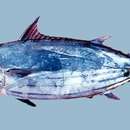Diseases and Parasites
(
англиски
)
добавил Fishbase
Caligus Infestation 2. Parasitic infestations (protozoa, worms, etc.)
- лиценца
- cc-by-nc
- авторски права
- FishBase
Trophic Strategy
(
англиски
)
добавил Fishbase
Aggregations of this species tend to be associated with convergence, boundaries between cold and warm water masses (i.e., the polar front), upwelling and other hydrographic discontinuities. Normally inhabit waters with surface temperatures of 20°C to 30°C (Ref. 28951). However, adults are sometimes present in waters as cold as 15°C (Ref. 168, 28950). Stay near the surface at night. School near the surface with birds, drifting objects, whales, sharks, and other tuna species and shows characteristic behaviors like jumping, feeding and foaming. Opportunistic feeders preying on any forage available. The feeding activity peaks in the early morning and in the late afternoon.Skipjack tuna also need a dissolved oxygen level of 2.5 ml per liter of sea water to maintain a minimum swimming speed, and require higher levels when active (Ref. 28952). This requirement generally restricts skipjack tuna to water above the thermocline and in some areas, such as the eastern Pacific, may exclude them from surface waters (Ref. 28952).The warm East Australian Current distributes skipjack tuna larvae into subtropical waters off eastern Australia (Ref. 28956). The larvae are generally limited to the upper 50 m of water and are most common in the sub-surface layers (Ref. 6390). Juvenile skipjack tuna less than 15 cm TL inhabit the same areas as larvae but generally move to cooler waters as they grow to maturity (Ref. 28956).There is little information on migration patterns for skipjack tuna in Australian waters. Skipjack tuna tagged in the Coral Sea, off Norfolk Island and off New South Wales have been recovered in waters off the Solomon Islands, New Caledonia, French Polynesia and New Zealand (Ref. 28959). The recapture in Australian waters of a few fish tagged in New Zealand and Papua New Guinea indicates that there could also be significant movement of skipjack tuna into the Australian Fishing Zone from the greater South Pacific (Ref. 6390).
- лиценца
- cc-by-nc
- авторски права
- FishBase
Morphology
(
англиски
)
добавил Fishbase
Dorsal spines (total): 14 - 16; Dorsal soft rays (total): 14 - 15; Analspines: 0; Analsoft rays: 14 - 15; Vertebrae: 41
- лиценца
- cc-by-nc
- авторски права
- FishBase
Migration
(
англиски
)
добавил Fishbase
Oceanodromous. Migrating within oceans typically between spawning and different feeding areas, as tunas do. Migrations should be cyclical and predictable and cover more than 100 km.
- лиценца
- cc-by-nc
- авторски права
- FishBase
Life Cycle
(
англиски
)
добавил Fishbase
In tropical waters, reproductively active female skipjack tuna spawn almost daily.
- лиценца
- cc-by-nc
- авторски права
- FishBase
Diseases and Parasites
(
англиски
)
добавил Fishbase
Lagenocystis Infestation. Parasitic infestations (protozoa, worms, etc.)
- лиценца
- cc-by-nc
- авторски права
- FishBase
Diseases and Parasites
(
англиски
)
добавил Fishbase
Didymocystoides Infestation (intestine). Parasitic infestations (protozoa, worms, etc.)
- лиценца
- cc-by-nc
- авторски права
- FishBase
Diseases and Parasites
(
англиски
)
добавил Fishbase
Didymocystoides Infestation (stomach). Parasitic infestations (protozoa, worms, etc.)
- лиценца
- cc-by-nc
- авторски права
- FishBase
Diseases and Parasites
(
англиски
)
добавил Fishbase
Kollikeria Disease. Parasitic infestations (protozoa, worms, etc.)
- лиценца
- cc-by-nc
- авторски права
- FishBase
Diseases and Parasites
(
англиски
)
добавил Fishbase
Oesophagocystis Infestation. Parasitic infestations (protozoa, worms, etc.)
- лиценца
- cc-by-nc
- авторски права
- FishBase
Diseases and Parasites
(
англиски
)
добавил Fishbase
Coeliodidymocystis Disease. Parasitic infestations (protozoa, worms, etc.)
- лиценца
- cc-by-nc
- авторски права
- FishBase
Diseases and Parasites
(
англиски
)
добавил Fishbase
Lobatozoum Infestation. Parasitic infestations (protozoa, worms, etc.)
- лиценца
- cc-by-nc
- авторски права
- FishBase
Diseases and Parasites
(
англиски
)
добавил Fishbase
Didymoproblema Infestation. Parasitic infestations (protozoa, worms, etc.)
- лиценца
- cc-by-nc
- авторски права
- FishBase
Diseases and Parasites
(
англиски
)
добавил Fishbase
Didymocylindrus Infestation 2. Parasitic infestations (protozoa, worms, etc.)
- лиценца
- cc-by-nc
- авторски права
- FishBase
Diseases and Parasites
(
англиски
)
добавил Fishbase
Didymocylindrus Infestation 1. Parasitic infestations (protozoa, worms, etc.)
- лиценца
- cc-by-nc
- авторски права
- FishBase
Diagnostic Description
(
англиски
)
добавил Fishbase
This species is distinguished by the following characters: body fusiform, elongate and rounded; teeth small and conical, in a single series; gill rakers on first gill arch numerous, 53-63; D1 XIV-XVI, dorsal fins separated by a small interspace (not larger than eye), the second followed by 7-9 finlets; anal fin followed by 7-8 finlets; pectoral fins short, with 26-27 rays; 2 flaps (interpelvic process) between pelvic fins; body scaleless except for corselet and lateral line; a strong keel on each side of caudal-fin base between 2 smaller keels. Colour of back dark purplish blue, lower sides and belly silvery, with 4-6 very conspicuous longitudinal dark bands which in live specimens may appear as discontinuous lines of dark blotches (Ref. 9684).
- лиценца
- cc-by-nc
- авторски права
- FishBase
Biology
(
англиски
)
добавил Fishbase
Found in offshore waters; larvae restricted to waters with surface temperatures of 15°C to 30°C (Ref. 6390). Exhibit a strong tendency to school in surface waters with birds, drifting objects, sharks, whales and may show a characteristic behavior like jumping, feeding, foaming, etc. Feed on fishes, crustaceans, cephalopods and mollusks; cannibalism is common. Spawn throughout the year in the tropics, eggs released in several portions (Ref. 35388). Eggs and larvae are pelagic (Ref. 6769). Preyed upon by large pelagic fishes (Ref. 6885). Also taken by trolling on light tackle using plugs, spoons, feathers, or strip bait (Ref. 9684). Marketed fresh, frozen or canned (Ref. 9340, 9684 ); also dried-salted and smoked (Ref. 9987).
- лиценца
- cc-by-nc
- авторски права
- FishBase
Importance
(
англиски
)
добавил Fishbase
fisheries: highly commercial; gamefish: yes; price category: high; price reliability: reliable: based on ex-vessel price for this species
- лиценца
- cc-by-nc
- авторски права
- FishBase

